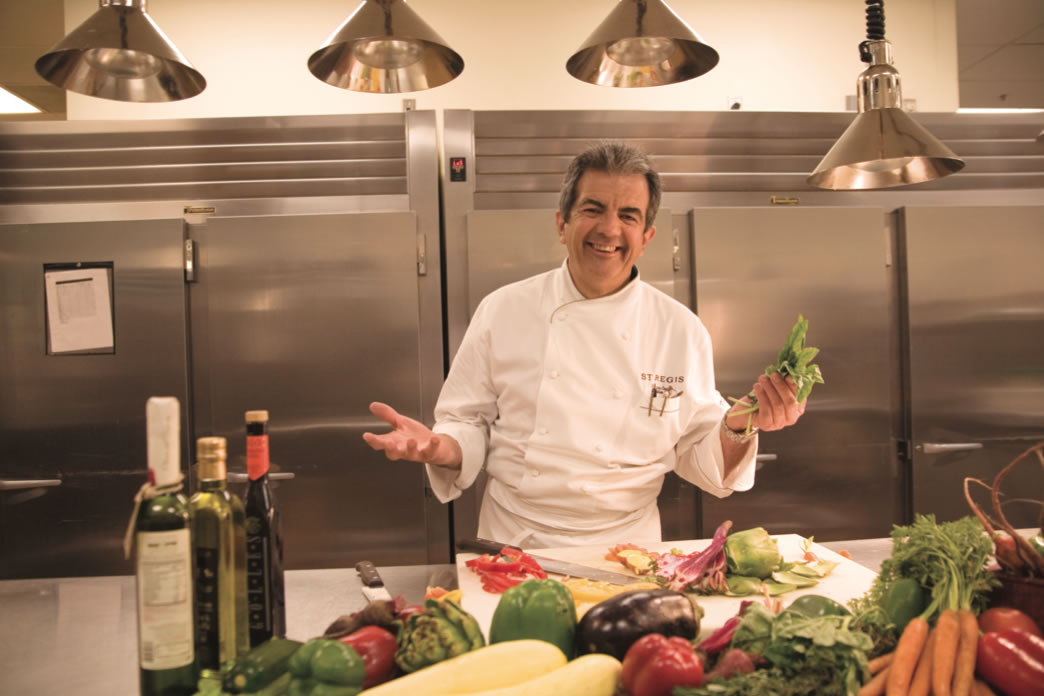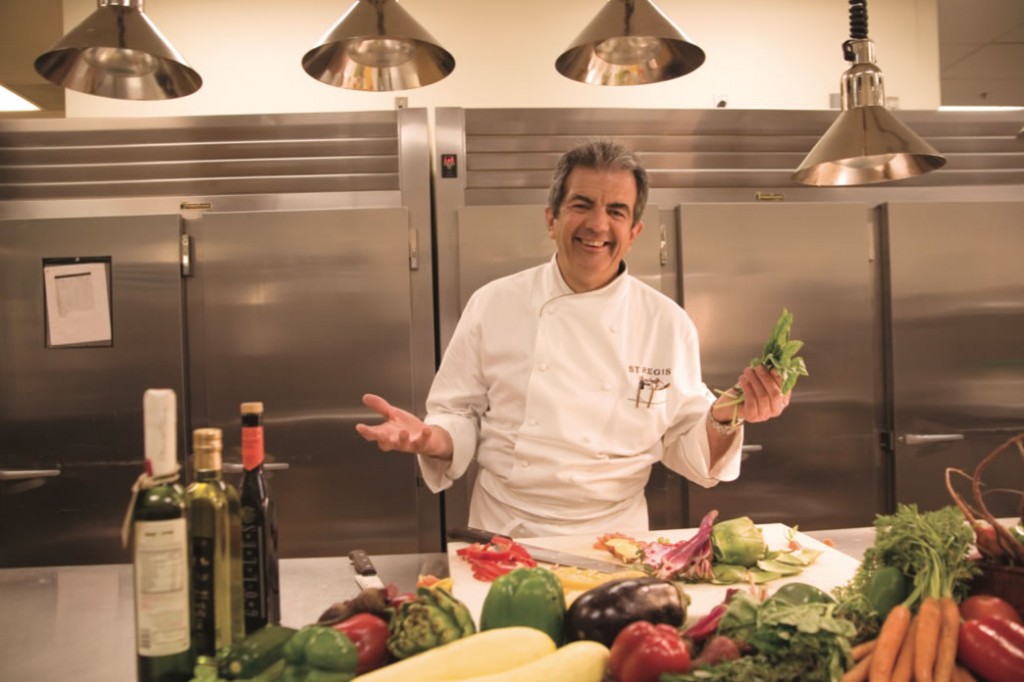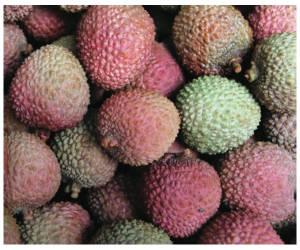Seasonal Delights
St. Regis chefs share their thoughts on savory summer foods, sustainability and shopping locally.
By Janie Franz
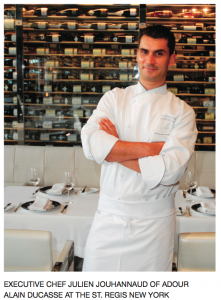 Summer is here, and the fields are lush with the tastes of the season. Like many home cooks, the St. Regis chefs are up to their culinary elbows, planning menus and using these summer treasures at the peak of their flavor. What summer ingredients are they having culinary dreams about? Where do they find those luscious morsels? What can we learn from these world-renown chefs about taste and where our food comes from? Here, we explore these questions and more with some of the St. Regis’ top chefs.
Summer is here, and the fields are lush with the tastes of the season. Like many home cooks, the St. Regis chefs are up to their culinary elbows, planning menus and using these summer treasures at the peak of their flavor. What summer ingredients are they having culinary dreams about? Where do they find those luscious morsels? What can we learn from these world-renown chefs about taste and where our food comes from? Here, we explore these questions and more with some of the St. Regis’ top chefs.
Inspiring Summer Ingredients
For The St. Regis Monarch Beach Executive Chef Frederic Castan, creating menus from a wealth of summer produce takes him back to his roots: “I was born and raised on a farm,” he says. Castan grew up in Avignon, France, an area with its own distinctive cuisine that has influenced his attitude toward food. “You don’t have to add too many ingredients, too many spices into a dish,” he says. “When you have the right fruit or vegetables that are grown organically on the farm, 60 to 80 percent of the dish is done because of the flavor. Everything is there. You don’t need much more.”
 Romuald Feger, executive chef at Vitrine restaurant in The St. Regis San Francisco, echoes Castan’s sentiments, adding that his favorite summer ingredient is the tomato. “I think we are blessed in San Francisco because when it’s tomato season, it’s just wonderful what you can get here,” Feger says. “Tomatoes in the region lean toward heirloom varieties that have rich flavors because they are allowed to stay longer on the vine and are picked ripe,” he explains. “Just slice them, add a little bit of fleur de sel, a little bit of olive oil, and nothing else. You can have a whole meal with five or six tomatoes and have a different experience each time you try even a bite of one.”
Romuald Feger, executive chef at Vitrine restaurant in The St. Regis San Francisco, echoes Castan’s sentiments, adding that his favorite summer ingredient is the tomato. “I think we are blessed in San Francisco because when it’s tomato season, it’s just wonderful what you can get here,” Feger says. “Tomatoes in the region lean toward heirloom varieties that have rich flavors because they are allowed to stay longer on the vine and are picked ripe,” he explains. “Just slice them, add a little bit of fleur de sel, a little bit of olive oil, and nothing else. You can have a whole meal with five or six tomatoes and have a different experience each time you try even a bite of one.”
Executive Chef Jordi Vallès of The St. Regis Bal Harbour waits all year for a very special summer ingredient—the Florida lychee, grown south of Miami and only available for six weeks out of the year. “It’s very unique,” Vallès says. “When you have a fresh one, the texture of the skin is so rough. Even when it’s 100 degrees outside, the inside of the lychee is so cold.” He uses the tropical fruit in restaurant specials, normally in desserts, such as his crème monte, similar to a crème anglaise, but substituting milk with 100 percent whipping cream infused with a mild-flavored ginger. “The lychee also pairs well with cold appetizers, such as fois gras,” he adds.
Like Vallès, Executive Chef Joe Trevino of The St. Regis Atlanta patiently waits for his favorite seasonal ingredient. Every year he anticipates fresh sweet corn, available in the south from late spring through summer. “It’s such a simple, yet versatile ingredient,” he says. “One of the things that’s going on the new menu for our signature restaurant is a corn velouté that will be paired with a fava bean accompaniment.”
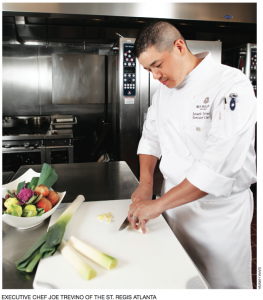 Julien Jouhannaud, executive chef of Adour Alain Ducasse at The St. Regis New York, eagerly awaits summer every year, looking for early produce that emerges at the start of the season. “I enjoy all types of green vegetables, such as English peas, fava beans, haricots verts, spring onions, ramps, green asparagus,” he says. “Later in the summer, I find tomatoes and zucchinis.” He even orders fresh morels from Oregon when they are available. These ingredients find their way into a number of dishes on his menu, many of them retaining their original rich flavors when gently cooked.
Julien Jouhannaud, executive chef of Adour Alain Ducasse at The St. Regis New York, eagerly awaits summer every year, looking for early produce that emerges at the start of the season. “I enjoy all types of green vegetables, such as English peas, fava beans, haricots verts, spring onions, ramps, green asparagus,” he says. “Later in the summer, I find tomatoes and zucchinis.” He even orders fresh morels from Oregon when they are available. These ingredients find their way into a number of dishes on his menu, many of them retaining their original rich flavors when gently cooked.
At The St. Regis Houston, Executive Chef John Signorelli anticipates the fresh flavors of summer’s light and vibrant vegetables. “Summer gives me the opportunity to put some new things to the flavor palate to really stand out,” he says. “For summer, I typically look for striped beets, peas, squash and radishes, which are fantastic. The things I look forward to most are greens, like lemon sorrel and shiso, if I can find it.”
In Dana Point, Calif., chef Castan uses seasonal ingredients to add a sweet addition to his dishes. “All of the stone fruit will be in season by June, July, August, all of the apricots, different peaches, different plums,” he says. “We create chutney with that and some sauces. And for dessert we use peaches in different ways—one with ice cream, the other with a dessert more like a cake.”
A Dish for All Seasons
While all of the St. Regis chefs claim different ingredients of choice, each stresses the importance of cooking with the seasons. “My philosophy is that if it’s not in season, we really shouldn’t be utilizing it,” chef Signorelli says.
Seasonality means using products at the right time, chef Feger explains. He has a unique take on eating seasonally, comparing it to the anticipation in waiting every year for the holiday season. “Christmas is one time of the year, and you anticipate that time because of what it brings … similar to how you expect the cherry season and you wait for your cherries that are good and sweet,” he says. “It doesn’t make sense to get cherries from Chile just to have cherries on your table or your menu. You just wait a couple of months, and then you get them here—I think that’s the joy of what nature is.”
However, sometimes cooking seasonally is easier said than done. When one of Vallès’ chefs wanted to create menu items in May using Georgia peaches, a fruit that isn’t ripe until July, he had to look elsewhere for an in-season substitute. He sourced another variety called the doughnut peach (also known as the Saturn peach), waiting until mid-summer to incorporate the juicy peaches from
Georgia into his dishes. “If you use a product at the wrong time, it’s not going to be ripe enough—it’s going to be too acidic and the texture is too hard,” he explains.
Chef Trevino plans to change his own corn velouté dish throughout the seasons. “For the spring we’ll add artichokes to it to provide some additional texture,” he says. “As that translates to summer, we’ll do parsnips to add a sort of variation to the corn as a nice complement.”
“Chef Alain Ducasse and I always give a lot of attention to the seasons,” chef Jouhannaud adds. Having experience in European and American restaurants, he has learned to use many ingredients as they become available locally through the abundant summer season. He changes his menu accordingly. “Until late spring I’ll be doing a cook pot of assorted green vegetables,” he says. “During the summer, the cook pot will probably be made as a Bayaldi, which is a version of a ratatouille.”
On the opposite coast, chef Castan says that the great availability of produce in California allows him to prepare a wide variety of flavors, colors and textures in his dishes. “I know by May or June that we have zucchini, different types of squash, baby ones,” he says. “Maybe turnips, in very beautiful colors—they are pink and white.”
With heirloom tomatoes, he does something quite unique. “We will probably do a cold soup made with tomatoes and probably a tomato sorbet as well. Also a tomato salad with a nice burrata that we found on a farm not too far from here,” he adds.
Farm Fresh
Local farmers are great resources for St. Regis chefs, who depend on the farmers for not only products but also advice and referrals to others in the area for hard-to- find items.
“I definitely keep in touch with the farmers around here,” chef Castan says. “They send me an e-mail every day or I visit them, so I can find out what’s coming up in the field in the next few weeks or so. That is my guideline. Depending on what they have, I create a menu from it.”
In chef Signorelli’s experience, farmers often have an expansive network that opens up channels far wider than the average grocery store. A visit to the local farmers market can yield a bevy of organic products farmed using traditional methods, not to mention the opportunity to explore and talk to the farmers.
In addition to typical farmers market items, chef Castan also sources a local olive oil from nearby Temecula, Calif. The Temecula Olive Oil Company not only has organic virgin olive oil, but flavored oils as well, including orange, lemon, roasted garlic, basil and even smoked varieties. As an exclusive to The St. Regis Monarch Beach, the company is also making a special house blend just for Castan’s restaurant.
Cooking with products selected at the peak of their flavor and produced by local farmers and food artisans supports the local economy, trims culinary costs, and enables the most flavorful, eye-appealing dishes to grace restaurant and home tables across this country. Anticipation of what goodies are in store can become a culinary Christmas that unfolds throughout the year.
Welcome to the Club
As the final piece of The St. Regis Aspen Resort’s
$40 million redesign puzzle, plans for the resort’s new restaurant called for something monumental—Chefs Club by FOOD & WINE, which opened in June, does not fail to deliver. Founded in partnership with acclaimed FOOD & WINE magazine, Chefs Club by FOOD & WINE marks the publication’s first foray into the restaurant industry.
FOOD & WINE is most noted for its illustrious Best New Chef awards, which have been presented to 250 chefs across the country since 1988, including culinary giants Thomas Keller, Tom Colicchio and Traci Des Jardins. Chef’s Club by FOOD & WINE at The St. Regis Aspen Resort will bring in four of FOOD & WINE’s Best New Chefs for six months at a time, ensuring a restaurant whose menu is always evolving but whose top-notch quality and focus on seasonal ingredients remains consistent.
“FOOD & WINE has built a reputation in seeking out great chefs,” says Alex Seidel, 2010 Best New Chef and one of the four inaugural chefs at the helm of the new St. Regis restaurant. “There is something to be learned any time that you can surround yourself in a circle of quality people from around the country. So for me, the new restaurant can help to offer things you can learn from. Beyond that, it’s just a great opportunity to collaborate with some really great cooks.”

